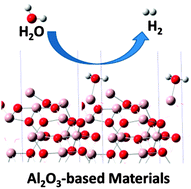Hydrogen generation by the reaction of H2O with Al2O3-based materials: a computational analysis
Abstract
The mechanisms for H2O adsorption on γ-Al2O3(110) surface were investigated to illustrate the influence of oxide modifiers on the hydrogen generation reaction. Periodic density functional theory (DFT) calculations with the projected augmented wave (PAW) approach were carried out to study the adsorption of H2O, OH, O and H species, as well as the reaction mechanisms of H2O splitting and H2 generation. Their corresponding structures and adsorption energies are also reported. The calculation results show that H2O, OH, O and H are preferably bound at Al(I)-top, Al(III)-bridge, Al(I,II)-bridge and Al(III)-bridge sites with adsorption energies of −0.42, −5.01, −8.70 and −2.38 eV, respectively. The potential energy profiles for water splitting and hydrogen generation on the γ-Al2O3(110) surface are mapped out. We find that hydrogen generation on the surface occurs via two processes, namely, H2O dehydrogenation and direct H2 generation with an overall exothermicity of 2.24 eV. The nonexistence of intrinsic transition-state barriers and the high exothermicity for the reaction of H2O(g) + γ-Al2O3(110) → O(ads)/γ-Al2O3(110) + H2(g) result in rapid H2 generation. The stepwise H2 generation mechanism of adsorption on the γ-Al2O3(110) surface was also demonstrated using first-principles molecular dynamics simulations. In addition, the nature of the interaction between the adsorbate and the surface during the reaction was also analyzed by the local density of states and by Bader charge calculations.


 Please wait while we load your content...
Please wait while we load your content...